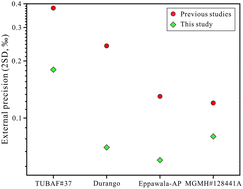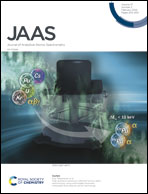High-precision apatite δ37Cl measurement by SIMS with a 1012 Ω amplifier Faraday cup†
Abstract
Chlorine is a redox-sensitive and fluid-mobile element, and is involved in many geological processes. Apatite, a ubiquitous accessory mineral in mafic to felsic rocks, is the most-studied mineral in chlorine isotope research due to its abundant structural chlorine [Ca5(PO4)3(F, Cl, OH)]. Although a wide δ37Cl range (up to 40‰) has been reported for extraterrestrial samples, the terrestrial apatite δ37Cl range is much narrower (0 ± 0.5‰) and thus high-precision measurement is necessary. However, analytical uncertainties of the published apatite δ37Cl by secondary ion mass spectrometry (SIMS) are generally above 0.20‰ (2SD; especially for Cl-poor (<1 wt%) samples), which are insufficient for most geological studies. To improve the analytical precision, we investigated the performance of a 1012 Ω amplifier Faraday cup (FC) for apatite δ37Cl measurement. A SIMS (CAMECA IMS 1280-HR) multi-collector system was adopted, and two movable FCs (L1 and H1, with 1011 Ω and 1012 Ω resistors respectively) were used to collect 35Cl and 37Cl ions. Four natural apatite reference samples (TUBAF#37, Durango, MGMH#128441A, and Eppawala-AP) with 0.27–1.55 wt% chlorine were analysed. Due to the low background noise of the 1012 Ω amplifier FC and the elimination of heterogeneous detector interference between the electron multiplier (EM) and FC, the precision (both single spot internal uncertainty and spot-to-spot reproducibility) is significantly improved. The internal uncertainty and spot-to-spot reproducibility can reach 0.10‰ (2SE) and 0.20‰ (2SD), respectively, for a low-Cl (0.27 wt%) sample, while the best reproducibility (0.06‰, 2SD) is achieved for the Eppawala-AP apatite (1.55 wt% Cl). Compared with published analyses of apatite with similar chlorine contents, the analytical precision has been improved by around a factor of two. Our results on the four apatite standards (with ∼1 wt% difference in the Cl content) show a linear correlation between the measured SIMS instrument mass fractionation (IMF) and the chlorine concentration in apatite, which need to be corrected in future analyses. The analytical accuracy is also improved, as deviation of the corrected SIMS values from those of the GS-IRMS analysis is below 0.05‰ for the three analysed reference materials (TUBAF#37, Durango and Eppawala-AP), whilst MGMH#128441A exhibits a large deviation of 0.35‰, possibly due to the poorly-constrained GS-IRMS results. This provides important guiding significance for future chlorine isotope analyses and warrants further investigation.



 Please wait while we load your content...
Please wait while we load your content...